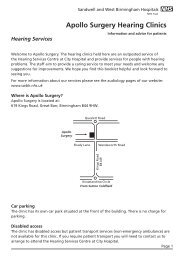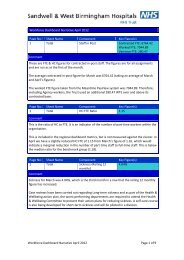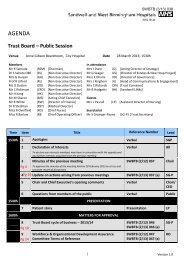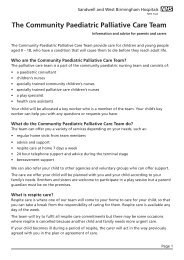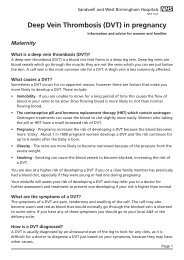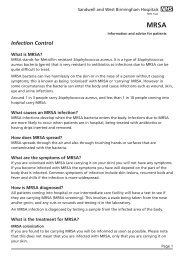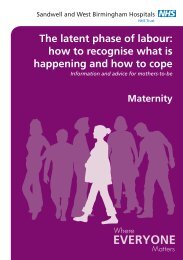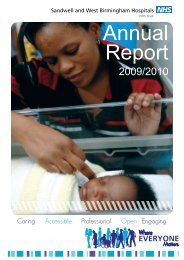Perineal tears - Sandwell & West Birmingham Hospitals
Perineal tears - Sandwell & West Birmingham Hospitals
Perineal tears - Sandwell & West Birmingham Hospitals
You also want an ePaper? Increase the reach of your titles
YUMPU automatically turns print PDFs into web optimized ePapers that Google loves.
<strong>Perineal</strong> <strong>tears</strong><br />
Information and advice for mums-to-be<br />
Maternity
What is a perineal tear?<br />
A perineal tear is a tear to the perineum – the area between the<br />
vagina and the anus (back passage) that occurs during childbirth. 85<br />
out of 100 women will have a perineal tear after a vaginal birth.<br />
Tear<br />
Vaginal<br />
opening<br />
Anus<br />
<strong>Perineal</strong> <strong>tears</strong> are graded by how severe they are:<br />
Labial <strong>tears</strong><br />
1st degree <strong>tears</strong><br />
2nd degree <strong>tears</strong><br />
3rd degree <strong>tears</strong><br />
4th degree <strong>tears</strong><br />
Tears to the skin on the labia (skin folds around<br />
the genital area).<br />
Tears to the skin of the perineum.<br />
Tears to the skin and muscle of the perineum.<br />
Tears to the skin and muscle of the perineum,<br />
and some of the muscle around the anus.<br />
Tears to the skin and muscle of the perineum,<br />
the muscle around the anus and the skin lining<br />
the anal canal.<br />
Some women need an episiotomy to help deliver their baby if the<br />
delivery is difficult and there are concerns about the baby’s heart<br />
rate. An episiotomy is a cut to the perineum which is performed by<br />
a midwife or doctor, using some local anaesthetic.<br />
What causes a perineal tear?<br />
2
In a lot of cases it is not possible to say why a tear occurred, but you<br />
are more at risk of a perineal tear if:<br />
• It is your first vaginal birth<br />
• The baby is in an unusual position<br />
• The birth is very quick<br />
• Forceps are used to help with delivery<br />
• Your baby weighs more than 4kg (8½ lbs)<br />
• You give birth lying down<br />
• The second stage of your labour lasts for more than 1 hour<br />
• Your baby’s head is delivered but one of their shoulders gets<br />
stuck behind your pubic bone (shoulder dystocia)<br />
How is a perineal tear diagnosed?<br />
After giving birth you will be examined by your midwife or doctor<br />
who will check for any <strong>tears</strong>. This examination is carried out gently<br />
but you will be able to use gas and air or have a local anaesthetic to<br />
numb the area if it is needed.<br />
If your midwife of doctor suspects you may have a 3rd or 4th degree<br />
tear you will be examined in theatre with a spinal anaesthetic.<br />
How are perineal <strong>tears</strong> treated?<br />
Labial <strong>tears</strong> – these are usually left to heal naturally. Although<br />
uncomfortable, they generally heal quickly.<br />
1st degree <strong>tears</strong> – If there is not excessive blood loss from the area<br />
these can also be left to heal naturally.<br />
2nd degree <strong>tears</strong> – A midwife will use some local anaesthetic to<br />
numb the area and will stitch the tear together. The stitches are<br />
dissolvable so do not need to be removed.<br />
3
3rd and 4th degree <strong>tears</strong> – These <strong>tears</strong> need to be repaired in<br />
theatre to stitch the damaged muscle and skin together. You will<br />
have an anaesthetic, usually an epidural, for the procedure so you<br />
will not be able to feel it. The stitches used are dissolvable so do not<br />
need to be removed. For more information about surgery to repair<br />
3rd and 4th degree <strong>tears</strong> please see the leaflet ‘3rd and 4th degree<br />
perineal <strong>tears</strong> after vaginal delivery’.<br />
An episiotomy needs to be repaired in the same way as a tear.<br />
Is there anything I can do to reduce my risk of having a<br />
tear?<br />
Although we know things that can increase the risk of a tear,<br />
in most cases we are unable to do anything to prevent a tear<br />
occurring. The following things may help to reduce your risk of<br />
having a tear, or reduce the severity of a tear:<br />
• Giving birth in water<br />
• Giving birth kneeling or in an ‘all fours’ position<br />
• Make sure you do not get constipated and need to strain<br />
to open your bowels (drinking plenty of water and eating a<br />
balanced diet will prevent constipation).<br />
• You may wish to massage your perineum using oil, as this can<br />
help to soften and relax the skin.<br />
It is also important that you eat a healthy balanced diet that<br />
contains iron, as women who have low levels of iron in their blood<br />
often heave <strong>tears</strong> that are slow to heal.<br />
4
After having a perineal tear<br />
Going home<br />
If you have a 1st or 2nd degree tear you should be able to go home<br />
within a few hours. If you have a 3rd or 4th degree tear you will<br />
normally be able to go when you have moved your bowels and you<br />
are not suffering too much pain.<br />
Pain<br />
It is normal for you to experience pain and soreness in your vagina<br />
and perineum while the area is healing. Taking painkillers such as<br />
paracetamol can help relieve pain. Please take them as instructed on<br />
the packet.<br />
Keeping clean<br />
It is important to keep your perineum clean by having regular baths<br />
or showers and changing your sanitary towels at least every 3 – 4<br />
hours to reduce your risk of developing an infection in the area.<br />
Wash your perineum at least twice a day while the area is healing.<br />
Please do not use any soaps or bubble baths etc on the area until<br />
it has healed. If you have had a 3rd or 4th degree tear you will be<br />
given antibiotics to reduce your risk of developing an infection.<br />
Going to the toilet<br />
Try to go to the toilet regularly. It is important that you avoid<br />
getting constipated as this can cause you to strain when you go to<br />
the toilet which could cause the repair to break down. If you have<br />
had a 3rd or 4th degree tear you may experience some changes in<br />
your bowel movements but this should settle in time. You will also<br />
be given a stool softener to take so that you don’t need to strain<br />
too much.<br />
Normal activities<br />
You can have sex whenever you feel ready. It is a good idea to use<br />
5
lubricants for the first time and try different positions if you find it<br />
difficult.<br />
You can go back to sport, swimming and driving when you feel able,<br />
you are no longer in pain and the area is healing well.<br />
Pelvic floor exercises<br />
Performing pelvic floor exercises regularly can help healing as the<br />
exercises improve the tone and strength of your muscles (your<br />
midwife will talk to you about these). Empty your bladder before<br />
doing the exercises and take 2 paracetamol before doing them if<br />
they cause any pain.<br />
Follow-up<br />
If you have had a 1st or 2nd degree tear you will not usually need<br />
a follow-up appointment; your midwife will check that you are<br />
healing well when he/she visits you at home and you can contact<br />
him/her for advice if you have any concerns.<br />
If you have had a 3rd or 4th degree tear you will be given a followup<br />
appointment with a consultant to check that you have healed<br />
well and that you don’t need any further treatment.<br />
Giving birth in the future<br />
Having a perineal tear will not affect the way you can give birth if<br />
you become pregnant again. You should be encouraged to have a<br />
vaginal birth when having your next child as there is no evidence<br />
that indicates a caesarean section has more benefit. Your midwife or<br />
doctor can discuss this with you in your next pregnancy.<br />
6
Symptoms to report<br />
After having a perineal tear, please contact your community<br />
midwife or GP if you experience any of the following:<br />
• Pain that is getting worse<br />
• Difficulty going to the toilet that is not improving<br />
• Incontinence that is not improving<br />
• Difficulty having sex that is not improving<br />
• Vaginal discharge that is smelly<br />
• Vaginal bleeding that is not getting better<br />
• A high temperature (above 38 °C)<br />
• Leaking faeces or being unable to control passing wind<br />
You can also contact the delivery suite for advice if you are<br />
concerned.<br />
Contact details<br />
Delivery Suite<br />
0121 507 5449<br />
Further information<br />
NHS Choices Pregnancy and Baby Guide<br />
www.nhs.uk/planners/pregnancycareplanner<br />
For more information about our hospitals and services please see<br />
our websites www.swbh.nhs.uk and www.swbhengage.com or<br />
follow us on Twitter @SWBHnhs and Facebook<br />
www.facebook.com/SWBHnhs.<br />
7
Sources used for the information in this leaflet<br />
• Royal College of Obstetricians and Gynaecologists, green-top<br />
guideline 29 ‘The management of third- and fourth-degree<br />
perineal <strong>tears</strong>’, March 2007<br />
• National Institute for Health and Clinical Excellence, CG55<br />
‘Intrapartum care: Care of healthy women and their babies<br />
during childbirth’, September 2007<br />
• Patient UK Professional Reference, ‘Episiotomy and Tears’, March<br />
2010<br />
• A.D.A.M Medical Images<br />
If you would like to suggest any amendments or improvements to this leaflet<br />
please contact the communications department on 0121 507 5420 or email:<br />
swb-tr.swbh-gm-patient-information@nhs.net<br />
A Teaching Trust of The University of <strong>Birmingham</strong><br />
Incorporating City, <strong>Sandwell</strong> and Rowley Regis <strong>Hospitals</strong><br />
© <strong>Sandwell</strong> and <strong>West</strong> <strong>Birmingham</strong> <strong>Hospitals</strong> NHS Trust<br />
ML3992<br />
Issue Date: December 2012<br />
Review Date: December 2014




